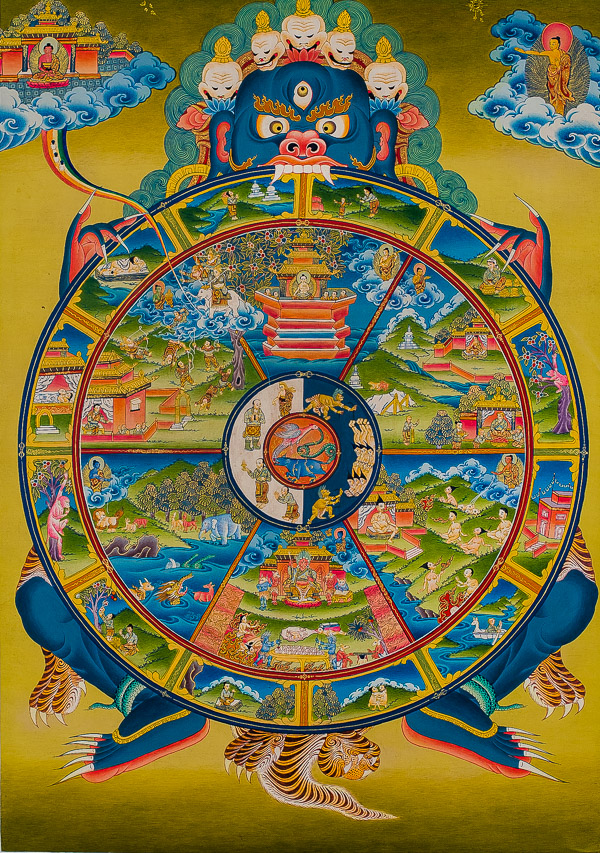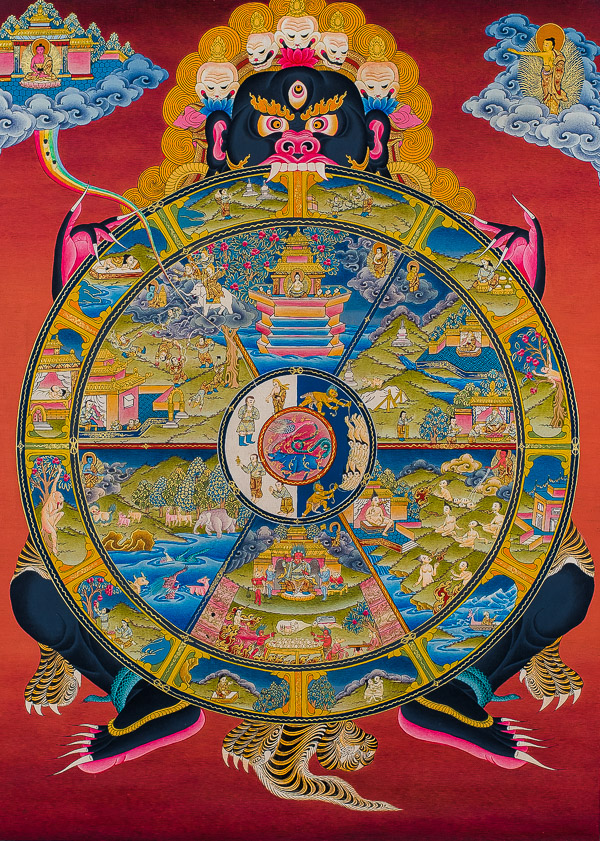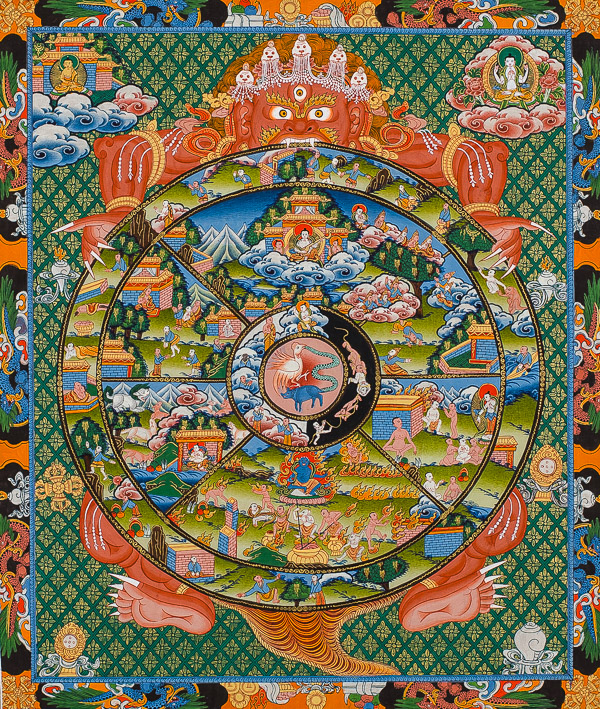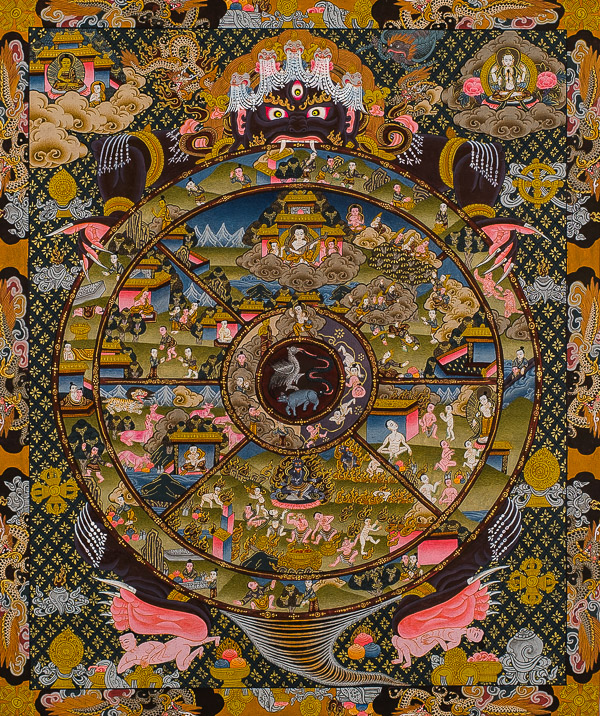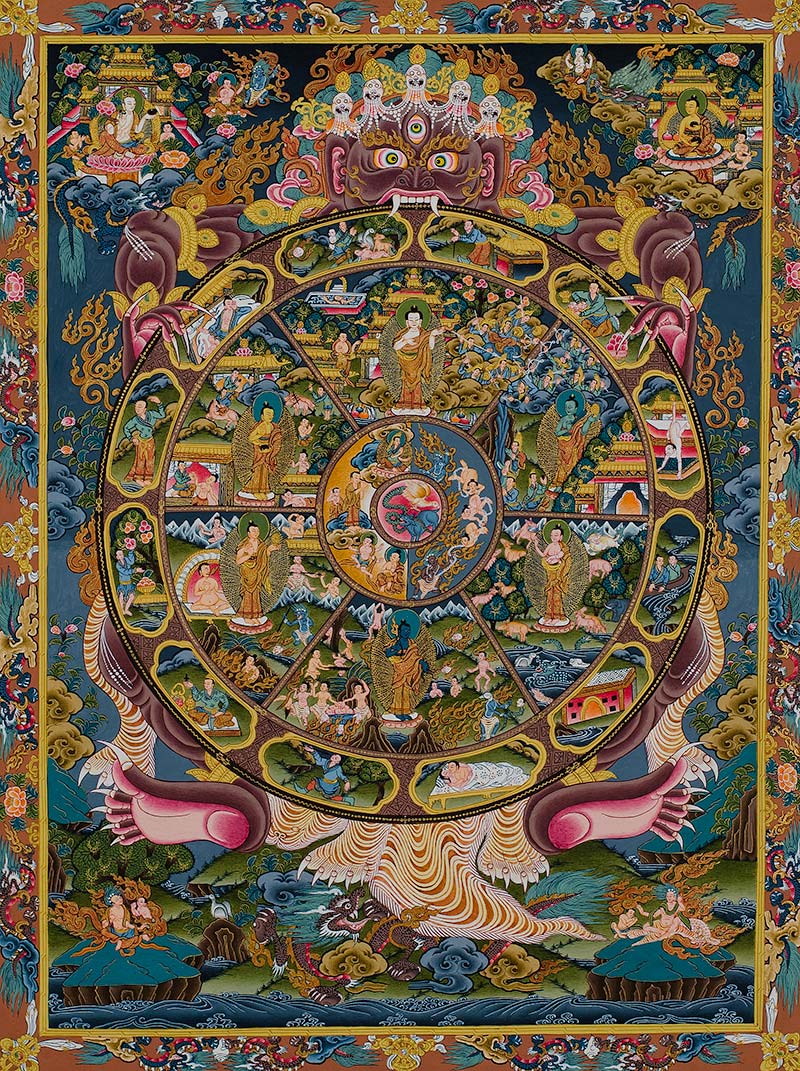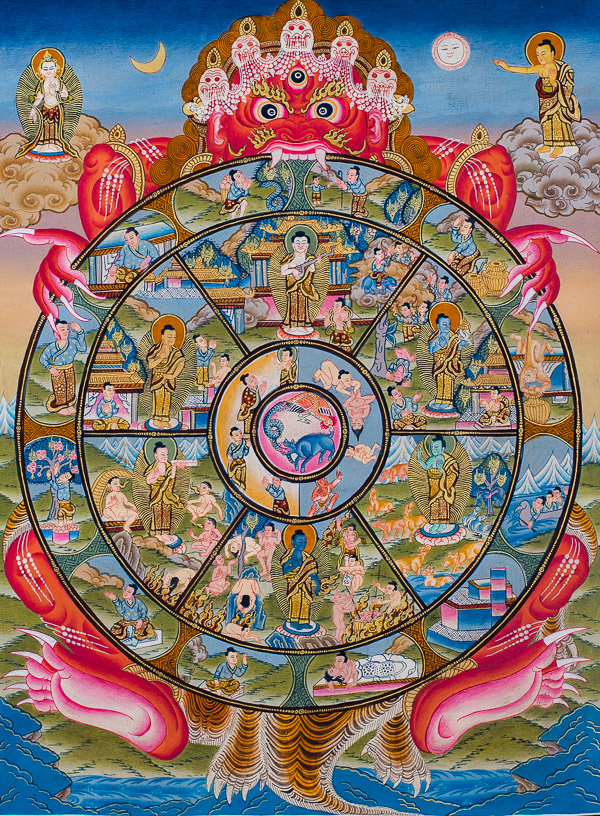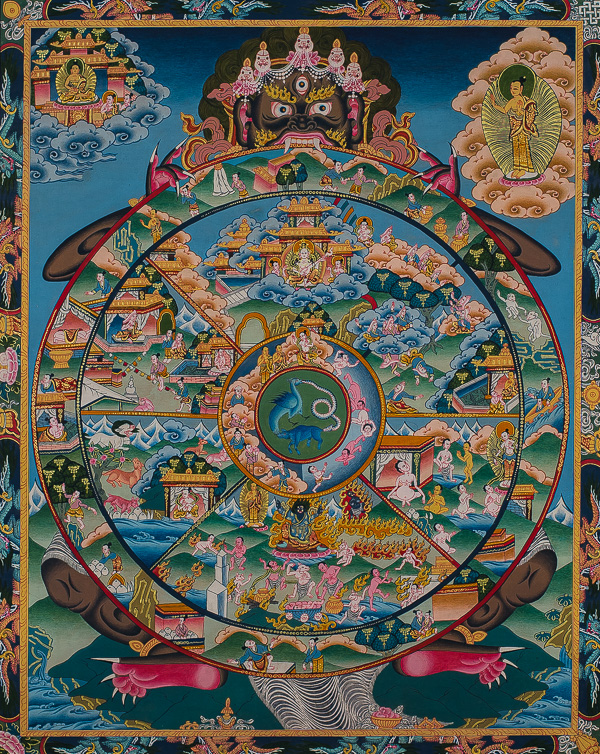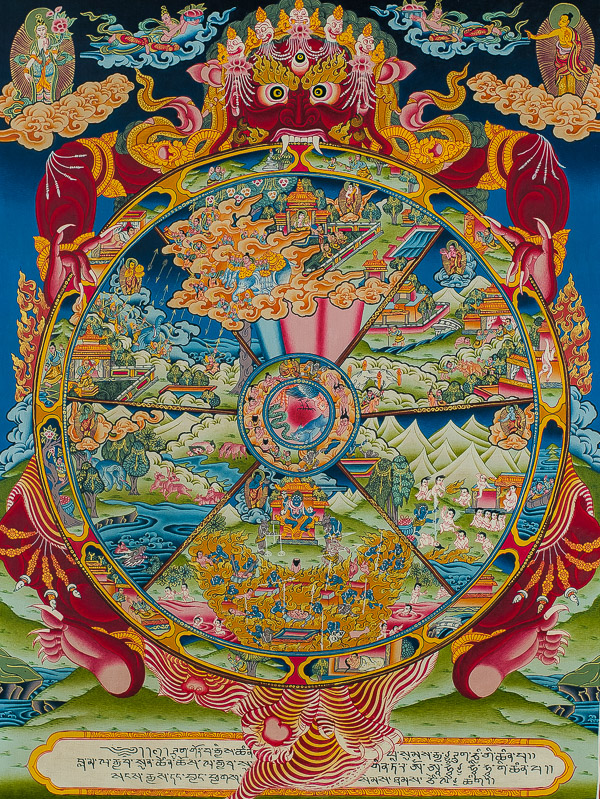Wheel of Life
tibetan. samsara or bhavachakra sanskrit.
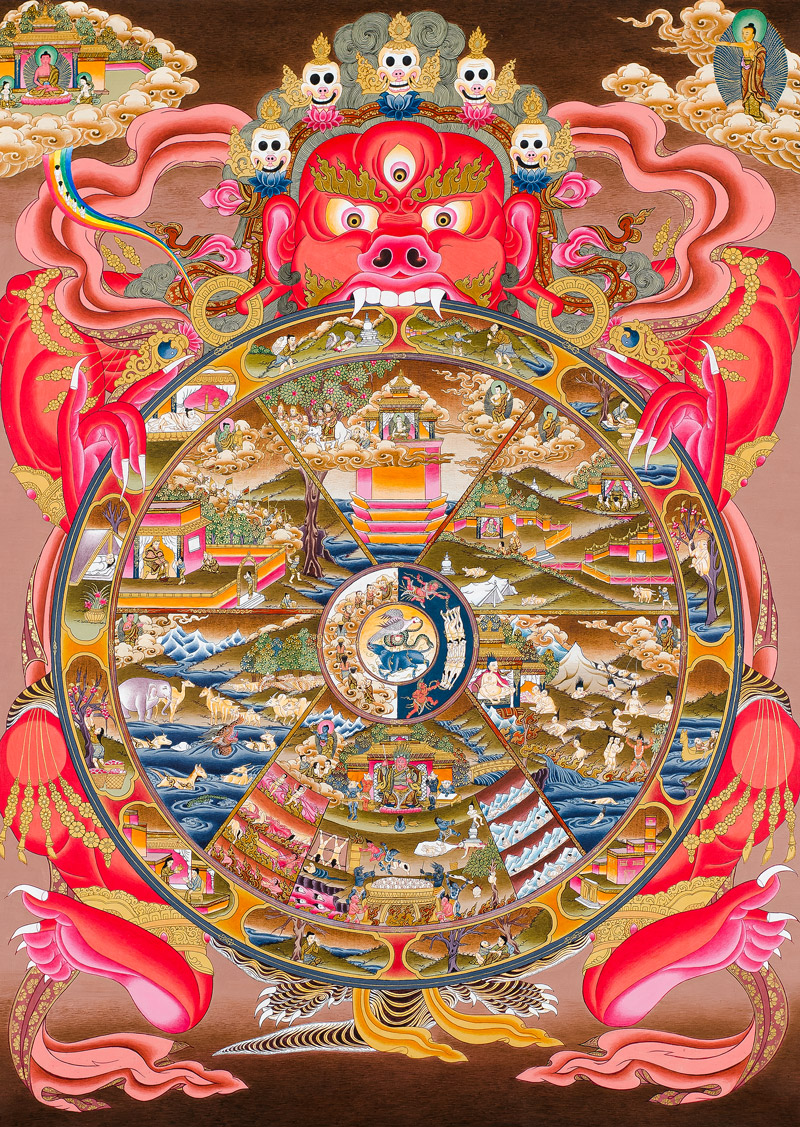
Introduction
This Thangka is perhaps one of the most powerful examples of Buddhist Iconography. It describes the Buddhist philosophy and introduces the notion of re-incarnation. This painting is often found on the entrances of monasteries and is believed to have been used by wandering monks to propagate Buddhism in its early years.
Samsara begins at the subconscious state of Bardo, continues into birth and is completed at the moment of death, thus the imagery or literal translation: the Wheel of Life.
It is essential to understand that in Buddhist thought, all existences are conditioned by: ignorance, suffering and the unexplainable flow of time, represented by Yama holding the wheel of life.
Nirvana, on the other hand, represents the world unaffected by negative emotions, which by definition is the nature of true happiness.
The endless cycle of birth, death and re-birth - or re-incarnation.
There exists many different styles and variations on the Wheel of Life, but it must be understood that these paintings reveal some of the most basic and fundamental concepts in Buddhist philosophy and the inmmense intricacy and precision of the work are testament to the thriving artistic culture of the Kathmandu Valley.
Six Worlds of the Wheel of Life
There exists 6 worlds: Gods, Titans, Humans, Animals, Hungry Spirits and Hell. With each birth our Karma matures, and finds itself in its corresponding "world". These different worlds of the Wheel of Life can also be split into 2 main groups:
- Three Upper Worlds (Gods, Titans and Humans) in which happiness is greater than suffering.
- Three Lower Worlds (Animals, Hungry Spirits and Hell) in which suffering is greater than happiness.
Individuals with similar Karmas, will have their consciousness experience a common perception, hence creating an identical world. Humans for example, all have identical sense organs (the 5 senses) which grant them access to an identical world (ours).
Buddhism however allows a multiplicity of possible manifestations, each functioning in what science would describe as a parallel "universe". We can only perceive ours and the Animal world.
From a Buddhist perspective, the fact we cannot perceive the other worlds does not condemn their existence, but further proves that we are blinded by what we can see, touch, taste, hear and smell. If you wish to read a more detailed description of some of the six worlds of samsara or a detailed look at the 12 interdependent factors please click on the links or check out our blog.
Our Collection
- None
- Date
- Price
- All
- small
- medium
- large
- extra large
- All
- black
- blue
- yellow
- brown
- green
- orange
- purple
- red
- black & gold
- red & black
Wheel of Life
Wheel of Life, small, yellow, Cotton Canvas, Gold Leaf, Gouache, OptionalThis beautiful Wheel of Life is a perfect interpretation of the concepts behind Samsara. Each detail is carefully painted to give us a stunning Thangka that has many traits of the Thangka style. Although this Thangka is not of a very...
Wheel of Life
Wheel of Life, red, small, Cotton Canvas, Gold Leaf, Gouache, OptionalThis beautiful Wheel of Life is a perfect interpretation of the concepts behind Samsara. Each detail is carefully painted to give us a stunning Thangka that has many traits of the Thangka style. Although this Thangka is not of a very...
Wheel of Life
Wheel of Life, green, small, yellow, Cotton Canvas, Gold Leaf, Gouache, OptionalThis beautiful Wheel of Life is a perfect interpretation of the concepts behind Samsara. Each detail is carefully painted to give us a stunning Thangka that has many traits of the Thangka style. The unique border painted and detailed...
Wheel of Life
Wheel of Life, brown, small, yellow, Cotton Canvas, Gold Leaf, Gouache, OptionalThis beautiful Wheel of Life is a perfect interpretation of the concepts behind Samsara. Each detail is carefully painted to give us a stunning Thangka that has many traits of the Thangka style. The unique border painted and detailed...
Wheel of Life
Wheel of Life, blue, medium, yellow, Cotton Canvas, Gold Leaf, Gouache, OptionalThis beautiful Wheel of Life is a perfect interpretation of the concepts behind Samsara. Each detail is carefully painted to give us a stunning Thangka that has many traits of the Thangka style. The unique border painted around the...
Wheel of Life
Wheel of Life, blue, brown, small, Cotton Canvas, Gold Leaf, Gouache, OptionalThis harmonious Thangka of the Wheel of Life is a great buy for those with a smaller budget. Although the Thangka is quite small each and every detail has been carefully painted to create a beautiful and clean Thangka. A skill that...
Wheel of Life
Wheel of Life, blue, small, Cotton Canvas, Gold Leaf, Gouache, OptionalThis beautiful Thangka of the Wheel of Life is painted in a soothing shade of blue and has a carefully painted border around the motif. This unique Thangka is perfect for those with a small budget seeking a beautiful Wheel of Life at a...
Wheel of Life
Wheel of Life, blue, small, Cotton Canvas, Gold Leaf, Gouache, OptionalThis Thangka of the Wheel of Life is painted in shades of blue and although wheel of life is quite small, each detail has been carefully painted to respect the iconography. The particularity of this Wheel of Life is the prayer that is...

